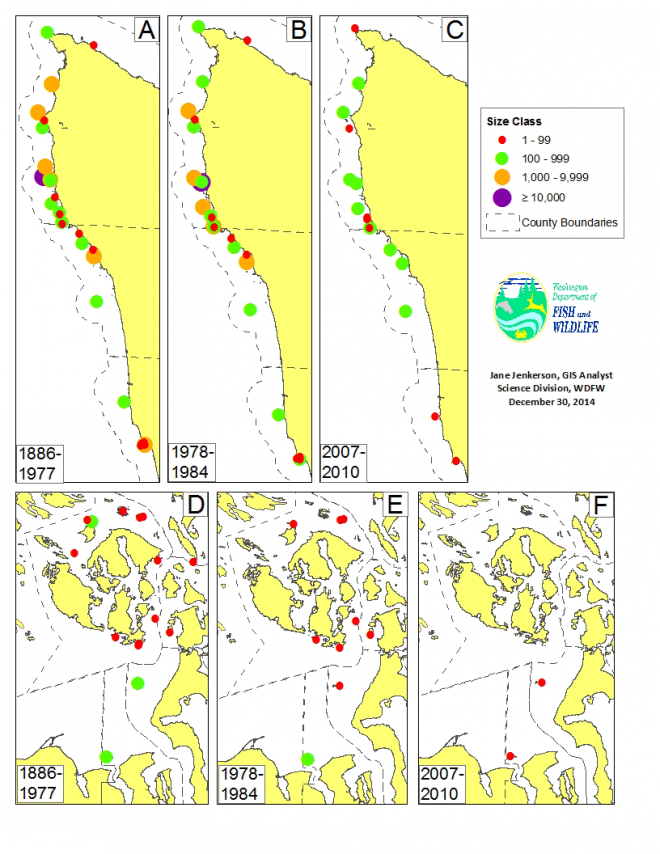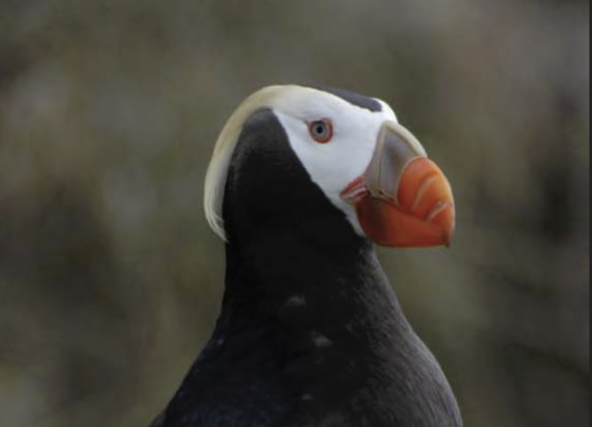Tufted Puffin (Fratercula cirrhata)
With its striking plumage and brilliant orange bill, the Tufted Puffin is an iconic seabird well known to native peoples, fishermen, and coastal communities throughout its range in the temperate and sub-arctic North Pacific. Though pelagic in winter, puffins gather on islands and headlands during spring and summer to breed and raise their young. They are members of the auk family, with stocky bodies adapted to “flying” underwater as they dive in pursuit of a wide range of fish and invertebrate prey. Nesting Tufted Puffins range up to 100 km from their breeding colonies to forage for their nestlings, and are famed for carrying 20 or more small fish at one time, neatly lined up and carried crosswise in their large, brightly colored bills.
State Status: Endangered, 2015
Federal Status: Species of concern
Historically, 44 Tufted Puffin nesting colonies were documented in Washington and the bird was considered common in the San Juan Islands, the Strait of Juan de Fuca, and particularly along the outer coast of the Olympic Peninsula. The population along the outer coast was conservatively estimated at about 25,000 individuals in the early 1900s, and the statewide population remained in that range for much of the 20th century, with a 1978-1984 minimum estimate of 23,342 birds at 35 known sites. Recent surveys, however, found nesting birds at only 19 sites in 2007-2010 and resulted in a minimum outer coastal population estimate of 2,958 individuals in 2009. Maximum estimates once ranked nine colonies at 1,000 or more individuals each, with two reaching 10,000 or more, but no current breeding sites now hold more than a few hundred birds. Significant average annual rates of decline have been recorded on pelagic surveys west of Westport (13.6%, from 1972 to 2001) and coastal surveys from Cape Flattery to Point Grenville (8.9%, from 2001 to 2012). Taken together these studies strongly suggest that Tufted Puffins in Washington have undergone an order of magnitude population decline, which is ongoing, and a decrease in the number of occupied breeding colonies of 57% since 1886-1977 and 46% since 1978-1984. This declining trend corresponds with a broader geographic pattern of range contraction, population decline, and breeding colony disappearance noted throughout the southern portion of the species’ distribution, including California, Oregon, and Japan.
Causes for the decline are unknown, but potentially include a number of historical and recent factors such as reduced prey availability, changing oceanic and climatic conditions, entrapment in fishing nets, mortality from oil spills and chemical contaminants, human disturbance of breeding colonies, impacts from introduced species, and increased Bald Eagle predation. The largest known mortality event in Washington was the 1991 Tenyo Maru oil spill, which killed an estimated 9% of the state’s Tufted Puffin population. Rising ocean temperatures and other shifts associated with climate change are expected to reduce ocean productivity and forage fish populations throughout the North Pacific, creating a challenging environment for piscivorous birds like the Tufted Puffin.
The current conservation status and legal protections for Tufted Puffins include no specific management or recovery requirements for Washington’s population. Puffins in Washington are considered a species of concern by the U.S. Fish and Wildlife Service and have been petitioned for listing under the federal Endangered Species Act, but an evaluation to list the species will not begin until 2016 or 2017. At the state level, Tufted Puffins have been a candidate for listing since 1998 and have been identified by Audubon Washington as a species at high risk from the impacts of climate change. Given the rate of recent population decreases, widespread colony abandonment, ongoing threats from multiple factors, and the challenging ocean conditions expected for piscivorous seabirds in the years ahead, Tufted Puffins are likely to continue declining in Washington. If the current 8.9% annual rate of decline continues, the state’s population could become functionally extirpated within about 40 years. For these reasons, it is recommended that the Tufted Puffin be listed as endangered in Washington.
Surveys and monitoring
Tufted Puffins are currently included in long-term monitoring of seabird colonies in Alaska (Dragoo et al. 2010) and at Triangle Island, British Columbia (M. Hipfner, pers. comm.). Expansion of such surveys and standardization of protocols have been called for (USFWS 2005) and would be particularly relevant for Washington and other areas where the species is declining. Regular surveys or monitoring programs specific to Tufted Puffins have never been conducted in Washington. The investigation by P. Hodum et al. in 2007-2010 was the first statewide attempt to assess the status of puffin breeding colonies in 25 years. The species is counted on the water during annual boat-based surveys focused on Marbled Murrelets (S. Pearson, pers. comm.). It also has been surveyed during the Westport Seabirds trips traveling west out of Westport, Washington, since 1972, although a change in survey protocols has prevented meaningful analyses of count data since 2002. The species is also recorded during annual boatbased surveys in the San Juan Islands National Wildlife Refuge.
Restoration potential
Restoration of Tufted Puffins at current and former breeding sites in Washington was suggested in the wake of the 1991 Tenyo Maru oil spill, but never acted upon (Tenyo Maru Trustees 2000). Though stabilizing and increasing populations at current breeding sites should receive first priority, restoration may offer a future means of expanding breeding opportunities and buffering the species against decline. Restoration has never been attempted with Tufted Puffins, but the successful reintroduction of Atlantic Puffins to islands off the coast of Maine (Kress and Nettleship 1988) indicates that it may be possible. In a worldwide review of seabird restoration, Jones and Kress (2012) found a 60% success rate for alcid species. Recent colonization of Mandarte Island, British Columbia, by Rhinoceros Auklets (P. Arcese, pers. comm.) and increased numbers of forage fish in recent trawls in the San Juan Islands (K. Fresh, pers. comm.) suggest that conditions around some former nesting sites in Washington may be opportune for either natural re-occupation or reintroduction. Site selection would require careful analysis, however, to avoid encouraging puffins to reoccupy poorly suited sites.
Projects to restore natural habitat conditions at current and former nesting islands should also be undertaken or evaluated to conserve Tufted Puffins in Washington. These would include the removal of invasive plants and animals (see Factors Affecting Continued Existence – Introduced Species) and the replanting of native vegetation. Eradication of European Rabbits on Destruction Island is already under consideration (S. Pearson, pers. comm.) and control of non-native plants at Protection Island has been proposed (USFWS 2010).
This article was originally published by the Washington Department of Fish and Wildlife as part of its status report on Tufted Puffins: Washington State Status Report for the Tufted Puffin (2015)







